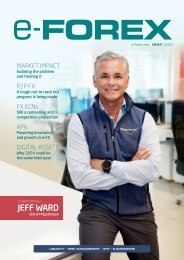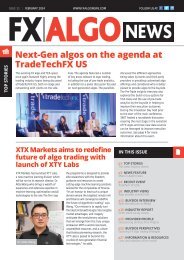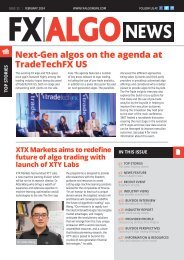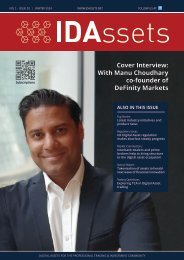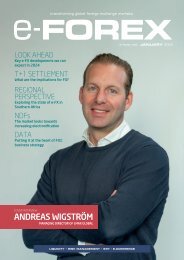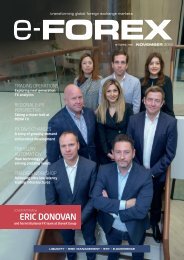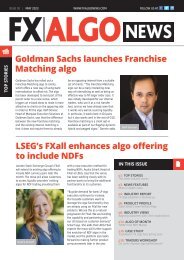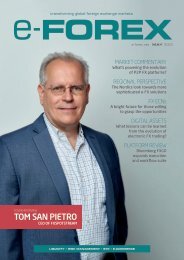Create successful ePaper yourself
Turn your PDF publications into a flip-book with our unique Google optimized e-Paper software.
Cutting through the hype: Where AI is already making its presence felt in FX<br />
FINTECH<br />
“The massive amount of fast moving data that is generated as<br />
a result makes AI analysis (and speed) highly suited to FX,”<br />
Tim Carmody<br />
when they trade, then automatically<br />
generating alerts for sales teams for<br />
clients who may need more attention.<br />
These AI generated alerts and signals<br />
can also be combined with proprietary<br />
algos hosted in the SmartTrade<br />
AlgoBox allowing a bank, if it wishes,<br />
to have automated reactions to these<br />
actionable insights.<br />
“This automation is clearly the<br />
direction of travel of the front office<br />
market,” says Culiniac. “How long<br />
it will take to develop and to what<br />
extent full automation will prevail of<br />
course depends upon the specifics of<br />
the bank, its clients, and the types of<br />
action we are considering.”<br />
Carmody agrees that both buy- and sellsides<br />
can benefit from using AI, although<br />
he suggests its access to vast resources<br />
probably gives the sell-side the edge.<br />
When asked how AI and machine<br />
learning is already being used in FX<br />
trading, Carmody says they are being<br />
deployed to synthesise data effectively<br />
from a large number of sources,<br />
with applied ‘interpretation’ such as<br />
sentiment analysis.<br />
“This data analysis is combined with<br />
market research and historical pattern<br />
recognition,” he says. “Real time<br />
transcription of voice trading is also<br />
being adopted more widely to create<br />
another source of data to feed into<br />
trading engines, alongside algorithmic<br />
order execution.”<br />
Culiniac says AI and machine learning<br />
have already revolutionised many<br />
aspects of FX trading.<br />
“They are used in data analysis to<br />
process vast quantities of market<br />
data to identify patterns and predict<br />
future price movements,” he explains.<br />
“In market research, AI algorithms -<br />
particularly those involving natural<br />
language processing - analyse<br />
sentiment from diverse sources to<br />
understand market influences.”<br />
For liquidity management, AI assists<br />
by forecasting supply and demand in<br />
the FX market, helping to pinpoint the<br />
optimal timing for trades and identify<br />
the most liquid trading pairs.<br />
“In risk management, AI systems<br />
identify potential market shifts or<br />
volatility spikes, adjusting trading<br />
strategies accordingly to mitigate<br />
risks,” adds Culiniac, who goes<br />
on to outline the potential risks of<br />
deploying AI that echo with some of<br />
the observations made in the OECD<br />
report.<br />
RISK CONSIDERATIONS<br />
“Deploying AI in loosely regulated<br />
markets such as FX carries risks<br />
associated with the concentration<br />
of power, systemic risk, and lack of<br />
transparency,” he says. “The use of<br />
sophisticated AI systems may further<br />
centralise trading power in large<br />
institutions, potentially exacerbating<br />
existing market inequalities.”<br />
AI-driven trading can also increase<br />
systemic risk if numerous systems are<br />
trained on similar data and implement<br />
analogous strategies, which could<br />
lead to a cascade of trades amplifying<br />
market volatility during certain<br />
conditions.<br />
“Finally, AI systems - especially those<br />
based on deep learning - are often<br />
perceived as ‘black boxes’ due to<br />
their complex and non-transparent<br />
decision making processes, which<br />
poses challenges for accountability,”<br />
continues Culiniac.<br />
Due to the perceived relative newness<br />
of the technology, some SmartTrade<br />
Technologies clients have chosen to<br />
use AI/machine learning tools to derive<br />
actionable information from their data<br />
and to enable them to have better<br />
conversations with clients, liquidity<br />
providers and internal stakeholders<br />
rather than to fully automate mission<br />
critical processes.<br />
“It is almost inevitable that as<br />
market acceptability increases and<br />
the technology matures we will see<br />
more and more aspects being fully<br />
automated in the front office as banks<br />
Alexander Culiniac<br />
“In risk management, AI systems identify potential market<br />
shifts or volatility spikes, adjusting trading strategies<br />
accordingly to mitigate risks,”<br />
68 JULY 20<strong>23</strong> e-FOREX




